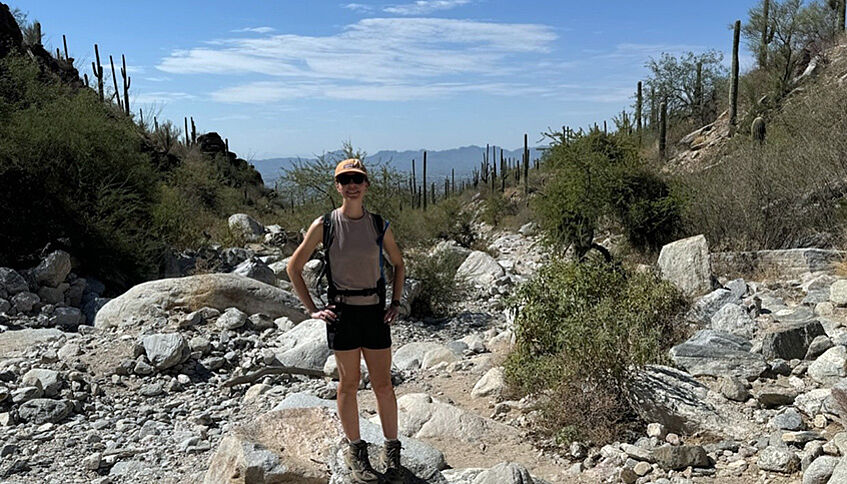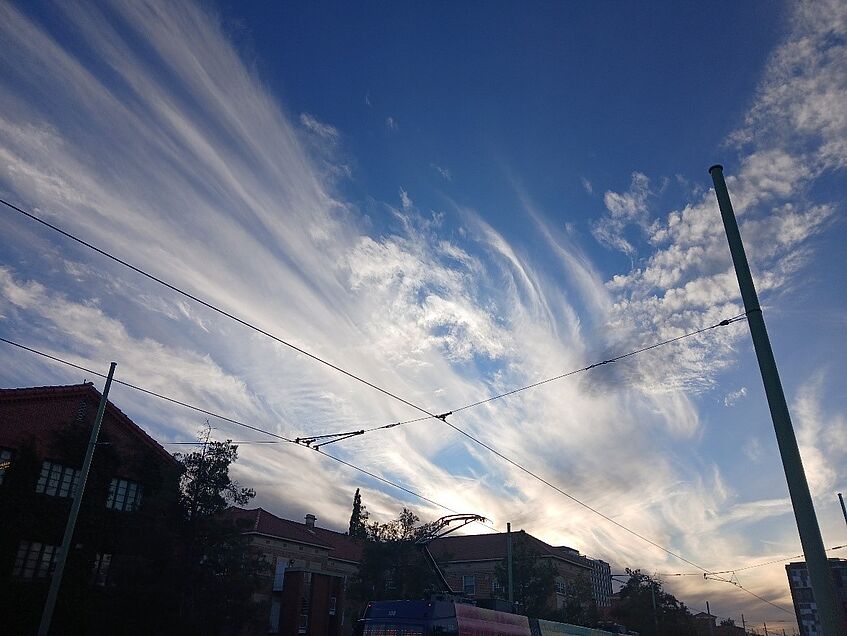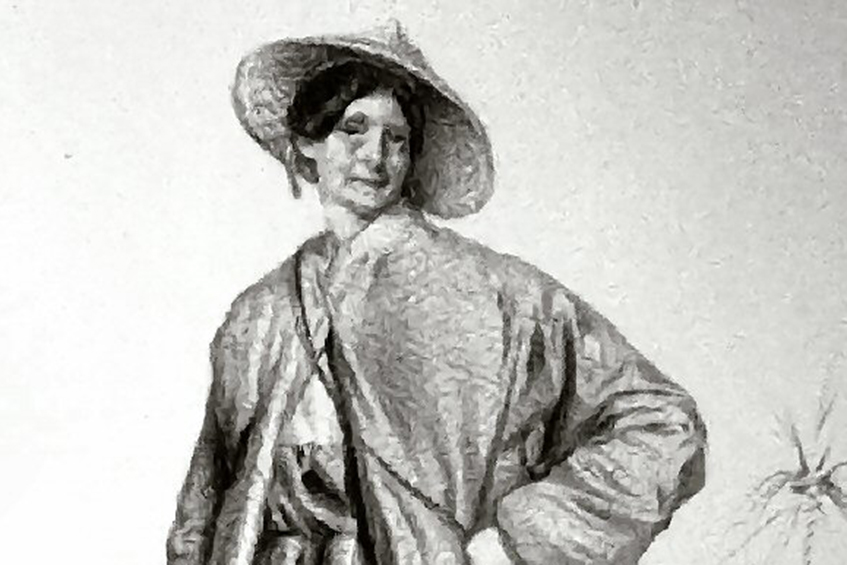Cloud research: "From aerosol nucleation at nanometers to the jet stream"
Cloud research: "From aerosol nucleation at nanometers to the jet stream"
28.05.2025
From May to August 2025, Sylvia Sullivan from the University of Arizona is Ida Pfeiffer Professor at our Faculty. The cloud physicist is concentrating on clouds and their impact on climate. She is fascinated with clouds since her graduate school time. For her, the huge range of spatiotemporal scales is part of what makes this field so interesting: "You are studying phenomena from aerosol nucleation at nanometers to the jet stream over tens of thousands of kilometers," she explains in her "Currently visiting" interview.
During her stay, Sylvia Sullivan gave course on Aerosol physics for Meteorology and Geosphysics students and a research talk within the Meteorological-Geophysical Colloquium on 17.06.2025.

Sylvia Sullivan (here hiking at “Finger Rock” in Tucson), is Ida Pfeiffer Professor from May until August 2025.
- In your research you are concentrating on clouds and their impact on the climate. Why clouds – what is so fascinating about them?

Clouds over the Mississippi River. Photo: Sylvia Sullivan
Sylvia Sullivan: I studied engineering in school but was always interested in environmental systems. When I entered graduate school at Georgia Tech, one of the professors was studying cloud condensation nuclei. His work caught my eye because he talked about flying aircraft through storms to sample clouds, which sounded amazing. I didn’t end up doing sampling, but I did end up staying in cloud physics! I think the huge range of spatiotemporal scales is part of what makes this field so interesting. You are studying phenomena from aerosol nucleation at nanometers to the jet stream over tens of thousands of kilometers.
- What are the difficulties in cloud research?

Dramatic clouds over Tucson. Photo: Sylvia Sullivan
Sylvia Sullivan: Because one is often comparing models and observations, one has to understand strengths and limitations of both. For example, remote sensing observations involve their own uncertainties, and one has to know the assumptions going into their retrieval algorithms when using their data as a baseline. Our group is expanding out into laboratory work, and another challenge there is ensuring experiments are atmospherically relevant. We need the control of lab experiments to inform model development but also have to be cautious that the experiments are not too simplified.
- You published a Wiley edition on Clouds and Their Climatic Impact in 2023, with most of the authors being in their early-career stage. Why did you focus on their view in this rapidly growing field?
Sylvia Sullivan: There are so many bright and talented young people working on clouds and climate, coming from different technical background and from different countries. I think that providing a platform for the work and ideas of these younger scientists was a primary purpose of the monograph. Having that goal in mind helped me feel like less of an upstart, while working on a task that more experienced climate scientists could have done very well.
Sylvia Sullivan about her research and career
- Which research findings in recent years have been most important in your field?
Sylvia Sullivan: A lot of high-impact research has pointed to optically thin ice clouds as key to our uncertainty about how much temperatures will rise in the years ahead (or climate sensitivity) (e.g., McKim et al., 2024; Sokol et al., 2024). I am also interested in mesoscale convective systems, and recent and interesting results of Feng et al., 2025 show that where and when we identify these storms in observations varies a lot from one dataset to the next. Lastly, I will mention the trend of performing OSSEs, or Observing System Simulation Experiments, in which real-world measurements are informed by models to maximize the new information we gain from them.
Sizes, Motion, Processes, Impacts
- You will teach Aerosol physics to our students during your stay. Which central message should your students remember?
Sullivan: I have taught Aerosol physics a few times now at the UofA and I tell the students on the first day to remember the course mantra, which is “Sizes, Motion, Processes, Impacts”, the four themes corresponding to the course objectives.
We talk about how to characterize aerosol sizes first, as motion, processes, and impacts are all highly size dependent. Then we talk about motion and processes because these come into play heavily for impacts. If students can remember the mantra, then hopefully it provides them an organizational framework to remember other concepts.
- Why did you decide to apply as Ida Pfeiffer Professor and join our Faculty for this summer term?
Sylvia Sullivan: I am very excited to work with Prof. Voigt and Dr. Gasparini again. I really enjoy working with them. I am also excited about the new research avenues that the Professorship may open, including exposure to data assimilation or microplastics studies. On the personal side, I have been to Vienna a few times for the Annual Meeting of the European Geophysical Union and know that it is amazing city with natural beauty, rich musical and artistic history, and good food. I am looking forward to spending more time there, especially during summer when weather at home (in Tucson, Arizona) is quite intense.
- Which three publications characterise your work?
- I’ll highlight our most recent publication led by Edgardo Sepúlveda Araya, a PhD student in my group, called “Sensitivity of ice cloud radiative heating to optical, macro-, and microphysical properties.” This study uses idealized, and one thrust of my research has centered on these kinds of simplified or single-parcel modeling.
- Then I’ll mention a Nature publication called “Ice microphysical processes exert a strong control on the simulated radiative energy budget in the tropics” that I co-authored with Prof. Voigt about 4 years ago. This used very high-resolution and full-complexity simulations to understand heating and cooling of clouds.
- And lastly I will include a PNAS publication from 2016 called “Role of updraft velocity in temporal variability of global cloud hydrometeor number”, which used global climate models and an adjoint sensitivity technique to understand which inputs most strongly influence output hydrometeor numbers. These three give a sense of the range of computational tools used in my research.
Ida Pfeiffer Professorship @ FGGA
The Ida Pfeiffer Professorship of the Faculty of Earth Sciences, Geography and Astronomy supports our mission to conduct excellent research on the sustainability of Planet Earth. Since 2018, the Faculty has been inviting scientists for one semester to trigger exciting research as well as teaching and act as a catalyst in the wide range of research topics addressed at the Faculty. Image: Ida Pfeiffer, Lithography by Adolf Dauthage
Thank you & welcome to our Faculty!
About the Person

Sylvia Sullivan is an Assistant Professor in the Department of Chemical & Environmental Engineering at the University of Arizona. She has a courtesy appointment and works closely with those in the Department of Hydrology & Atmospheric Sciences. She earned her Bachelors of Science from the California Institute of Technology in Chemical Engineering with a minor in Environmental Science in 2012. She then completed her PhD in Chemical Engineering at the Georgia Institute of Technology with a minor in Earth & Atmospheric Sciences in 2017. She was a postdoctoral researcher at both Columbia University in New York and the Karlsruhe Institute of Technology, for two year each, before joining the UofA. In her free time, she enjoys reading, running, hiking, swimming, and learning languages.
- Homepage
- Lab for Multiscale Cloud Modeling and Experimentation
- Working group / host professor at our Faculty: Aiko Voigt, Department of Meteorology and Geophysics
- Course in the summer term 2025: 280330 VU Aerosol physics

